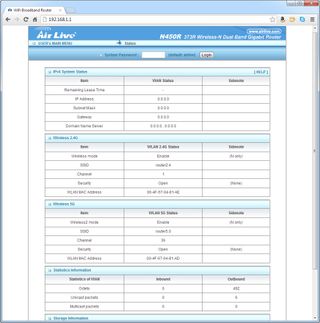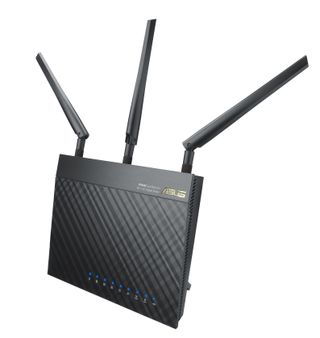Gigabit Wireless? Five 802.11ac Routers, Benchmarked
Five years ago, we didn't have homes with a dozen wireless nodes and the need to run HD video to multiple screens. Today we do. Our 802.11n networks, especially on the 2.4 GHz band, are swamped. Can 802.11ac save the day? We test six routers to find out.
AirLive N450R And Asus RT-AC66U
AirLive N450R
AirLive is the odd man out in our round-up. The N450R is a dual-band router, but it is not 802.11ac-compatible. Rather, it uses beamforming for dual-band 802.11n. The company specifies 450 Mb/s for 5 GHz and 300 Mb/s for 2.4 GHz. On paper, this looks to be the best 5.0 GHz that one can hope to get, short of hopping to 802.11ac. Also, we wanted a low-cost, high-performance example of prior-gen technology to compare against our 802.11ac line-up. AirLive tells us the router should be priced around $116. Unfortunately, though, it isn't available in the U.S.

Compared to the rich GUIs found in many top-name routers, AirLive’s menus are fairly plain, reflecting the sort of menus found in routers five or six years ago. That’s not to say they’re bad. The N450R comes stocked with all of the basic features we wanted, including thorough and understandable English documentation. As with all of the routers here, the N450R comes with four gigabit Ethernet ports and a Wi-Fi Protected Setup (WPS) button for easy connection with WPS-ready client adapters. AirLive also houses two USB ports for NAS storage and a 3G network adapter dongle.


Asus RT-AC66U
Like AirLive, Asus also employs three external antennas, but Asus goes nearly all out to maximize their potential. The RT-AC66U ($190 at Newegg) applies 3x3:3 on both radio bands, specifying 450 Mb/s for 2.4 GHz 802.11n and 1300 Mb/s for 5.0 GHz 802.11ac. To be clear, Asus does not specifically state that it uses beamforming, but the company’s "exclusive AiRadar technology" is able to "detect the direction" of connected clients and amplify their signals, which sure sounds like beamforming to us, though it could be something else. If you were so inclined, you could remove Asus’s detachable antennas and opt for higher-gain alternatives.

Our focus in this article is on hardware and performance, so we’re going to glance over a lot of usability and non-performance features. However, the RT-AC66U is a model of user-friendliness, starting with the browser-based setup process, host of internal monitoring screens, and perhaps the most attractive and intuitive menu system we’ve ever seen in a router.

Most of all, there’s AiCloud, which is a bit like having an Asus version of Pogoplug built into the router. Like AirLive, Asus builds in a pair of USB 2.0 ports, but AiCloud makes much better use of them. Essentially, any storage device (PC, NAS, USB, and so on) connected to the router can stream files through the AiCloud service and out to your Android or iOS mobile device or PC (via a Web browser). Compared to getting the same functionality through the old-school DDNS methods, AiCloud is effortless and immensely more gratifying.

Current page: AirLive N450R And Asus RT-AC66U
Prev Page Test Setup And Methodology Next Page Belkin AC1200 DB And Buffalo AC1300/N900Stay on the Cutting Edge
Join the experts who read Tom's Hardware for the inside track on enthusiast PC tech news — and have for over 25 years. We'll send breaking news and in-depth reviews of CPUs, GPUs, AI, maker hardware and more straight to your inbox.
-
boulbox Well, i can't wait until i can make my router give wifi all the way to my to my work area.(only a few blocks away)Reply -
I've tested both the R6300 and the RT-AC66U in my home. The R6300 beats it hands down. The average homes won't have the traffic that your artificial software creates. Even your tests show that R6300 in 5ghz mode is faster. People will buy these for gaming and HD movie viewing and the R6300 has better range as well. I've paired my R6300 with an ASUS PCE-AC66 desktop wireless AC adapter and I can acheive 30 MB/S (megabytes) to my HTPC in a 2 story house. That's an insane speed. The RT-AC66U only managed about 15 to 18 MB/s. Also make sure the R6300 has the latest firmware, which is V1.0.2.38_1.0.33. But in conclusion, the R6300 and the RT-AC66U are like a SRT Viper and ZR1 Vette. They are both great pieces of hardware to fit most users needs. Get the ASUS If you got a ton of traffic and a lot of 2.4 ghz devices. Grab the R6300 if you are looking for a friendly setup, max speed, and max range.Reply
-
fwupow Man it sure sucks when you type a long comment and it gets vaporized cuz you weren't logged in.Reply -
DeusAres I'd be happy with a 2Mb/s connection. It'd be better than this horrible 512 Kb/s connection I have now. At least then, I may actually be able to watch youtube vids in 360p.Reply -
fwupow Here's the gist of what I typed before it was rudely vaporized.Reply
I have a dual-band router (Netgear N600). I also purchased a couple of dual-band client USB adapters Linksys AE2500 or something to that effect.
So the USB adapter works fine for a desktop, but having that crap sticking out the side of a laptop, netbook or tablet? Busted in 10 minutes. I hooked one up to my netbook and fried it within a couple of weeks because I'm a Netbook in bed guy. You wouldn't think it could get so hot from a USB port but it does.
So the reality is that you have all these devices that can't be upgraded to dual-band and enjoy very little if any benefit from the new-fangled dual-band router.
The other beef I have with routers is that they're terrible with the way they split up bandwidth between multiple devices. Instead of responsively reassigning bandwidth to the device that needs it, the router continues to reserve a major slice for a device that I'm not using.
If you live in an apartment building, it's actually rather rude to use the full 300Mbps capacity of the wireless N band, since you may well succeed in effectively shutting your neighbor down. There's so much happening in the 2.4GHz band nowadays, it's unreal. Your own cordless keyboards/mice/controllers etc can malfunction from being unable to get a packet in edgewise.
For these dual-band routers to be really useful, we need manufacturers of smartphones, tablets, laptops, netbook and such to build dual-band clients into them because adding the functionality with some sort of dongle just doesn't work. -
memadmax I was a 802.11g and n "adoption" tester....Reply
Never again...
I'll give ac a year or two before I jump on it... -
SteelCity1981 my wireless N produces 300 Megabits which would equal around 37 Megabytes. My highspeed internet doesn't come cloe to reaching 37 megabytes and i don't transfer tons of files wirelesly and my wi-fi rangs is pretty good .So i'm perfectly fine with my 300MB N wireless router right now. Besides that none of my devices spport ac anyhow so it would get bottlenecked from reaching its full potential.Reply -
chuckchurch iknowhowtofixit"Folks, the time to start your 802.11ac adoption is now."I think this review proved that it is time to wait for 2nd generation wireless AC routers to appear before rushing to purchase.Reply
Exactly. The 'client' adapter they used if anyone didn't catch it was a Cisco/Linksys router-sized device. Not practical by any means. It'd be totally insane to make any product recommendations prior to real client adapters being available, or more accurately, embedded ones are available. I think a wireless salesman wrote this article.
